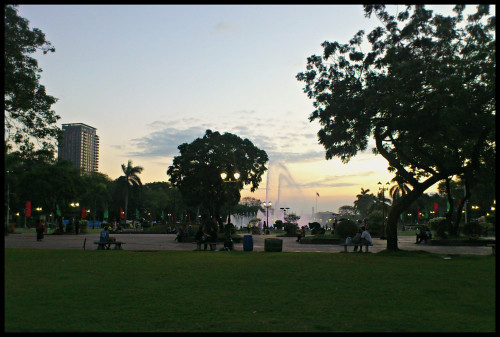Do you know that Manila is also called the ‘City of Our Affections’? It is. The nickname has quite a nice ring to it—it sounds, to me, a bit more thoughtful than the romantic ‘Pearl of the Orient’—but don’t, I advise, mistake “nice” and “thoughtful” for “feel-good.” To me, the nickname has always been injected with a certain pathos.
To questions of why, I’ll defer to a key part of “If These Walls Could Talk,” Carlos Celdran’s famous Intramuros tour, in which tour-goers are led into one of the historical district’s old American barracks in Fort Santiago. It’s the part that involves a pull-down projection screen and a slideshow featuring MacArthur and his Ray-Bans (in grainy sepia), a group of soldiers carrying the Japanese flag, and a black-and-white close-up of a bomb that half-eclipsed an aerial view of the city on which it was about to drop. The city in the photo—the city in which all the photos were taken—is Manila. You’re supposed to sit solemnly in a pew during this part, such that it seems wholly appropriate to call to mind the phrase, all together now, ‘City of Our Affections’—never mind if it must have caught on long before the war. Say it under your breath, and it takes on a strange, quiet wretchedness akin to that of a prayer being uttered at a funeral. A funeral for 100,000.
I do wonder sometimes: can these affections be evoked, be revived, without the help of a performance? Also: Manila is the city of whose affections, exactly? I don’t mean to be disagreeable. But last week, walking along Padre Burgos Street, I saw a homeless man just outside the gated golf course in Intramuros. He was peeing on the grass through a wire fence. (The newspaper men at the Manila Bulletin building in front could see his equipment, surely.) A few feet away, meanwhile, also on the sidewalk, was a young boy sleeping on a bed of rice sacks. Next to him a sign read, “Watch out! Flying golf balls.” His mother must have been the woman who was washing her clothes in the pool of water surrounding a monument: the Gomburza monument, I think it was. Why she chose to do her laundry there, I can’t tell you. The water was not clean, and on it sailed fallen leaves.
To be sure, Manila is not the city of these people’s affections. Turning the golf course into a urinal, sleeping on concrete, washing dirty linen in spaces reserved for marble heroes: like they would ever give a damn what the place is called. But it is because of them, hollow and sentimental as this sounds, that Manila might become the city of someone’s affections: mine. Not that I wish to take any credit for grand gestures of kindness subsequently performed—if you really want to know, I was only making my way to Muralla Street for dinner; affection could do with, but does not require, kind gestures. (As tourists often say, “You cannot save everybody.”) In any event: are these people not collateral damage, too? From a different war with a different name. I’ll let you call it whatever you like. What I’ll say is that if hearts grow fonder upon engagement in the remembrance of history, so must mine—if not every Manileño’s—on a walk today through the old city streets.
Which raises the question: why is the golf course still there?


No comments:
Post a Comment